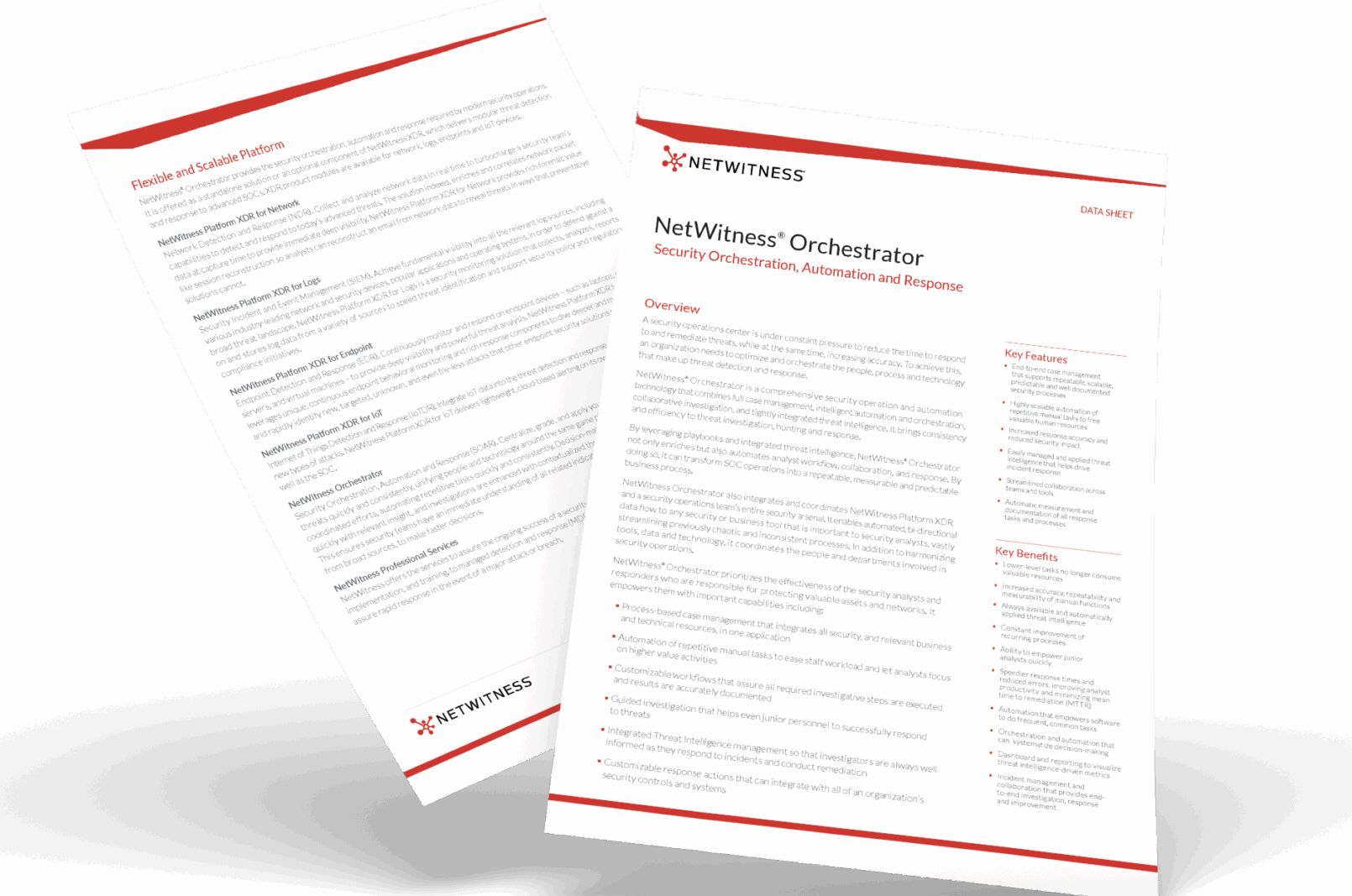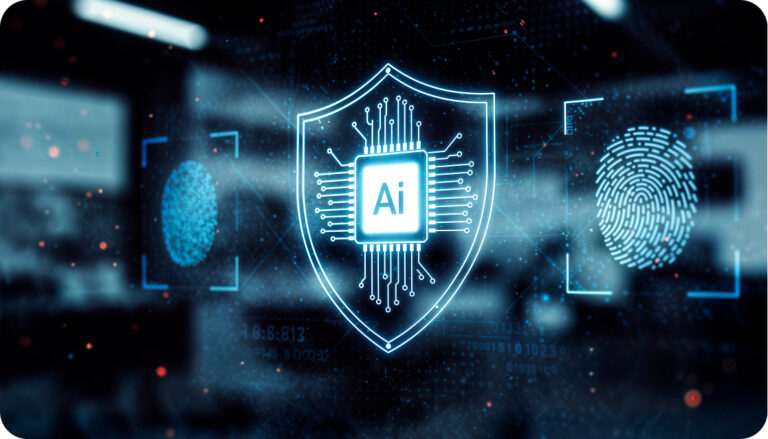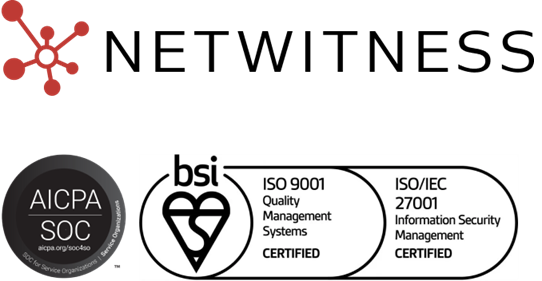Security operations centers face a fundamental paradox: the more data they collect, the harder it becomes to act on it. Organizations deploy extensive monitoring, capture millions of events daily, and still miss critical threats buried in noise. This is not a data problem—it’s an operational architecture problem.
SIEM and SOAR represent two distinct approaches to solving different stages of this challenge. Most organizations treat them as interchangeable or wonder which one to buy first, missing the deeper question: how do detection and response capabilities need to function together to create effective security operations?
The Core Problem SIEM Solves
Security Information and Event Management (SIEM) exist to solve a visibility problem that emerged when infrastructure became too complex for manual monitoring. The real challenge is not volume, it’s correlation across disparate data sources.
Consider what happens during a credential stuffing attack. Authentication logs show failed logins from multiple IPs, but each individual source looks benign—just a few attempts, nothing alarming. Web server logs show unusual geographic patterns. Network flow data reveals strange timing correlations. Endpoint logs capture subsequent lateral movement attempts. None of these signals, by themself, constitute a clear threat. Together, they reveal a coordinated attack.
SIEM aggregates these fragmented data sources and correlates events across time, systems, and context. It normalizes different log formats, applies temporal analysis, and identifies patterns that single-source monitoring cannot detect. This is why SIEM became foundational to security operations—it transforms scattered data points into coherent threat narratives.
But here’s where SIEM’s architecture creates limitations. Traditional SIEM operates on rule-based correlation and threshold detection. When event X happens, Y times within Z timeframe, generate an alert. This works for known attack patterns but struggles with novel attack sequences, low-and-slow attacks designed to stay under thresholds, and contextual nuance requiring environmental understanding.
Modern SIEM has evolved beyond simple correlation. Advanced implementations incorporate behavioral analytics, machine learning for anomaly detection, and risk-based scoring. Yet even sophisticated SIEM still fundamentally operates as a detection and analysis platform. It identifies what happened and surfaces potential threats, but the response remains manual.
Why SOAR Emerged as a Distinct Capability
Security Orchestration, Automation, and Response (SOAR) address a different bottleneck: the gap between detection and effective response.
When SIEM generates an alert, what happens next? An analyst must triage it, determine legitimacy, gather additional context from multiple tools, decide on appropriate response actions, execute those actions across different systems, document everything, and monitor to ensure effectiveness. This process might involve querying threat intelligence platforms, checking EDR for endpoint activity, reviewing email security for phishing attempts, examining network flows, accessing identity systems, coordinating with IT for isolation or credential resets, updating ticketing systems, and communicating with stakeholders.
For a single alert, this investigation might take 30-90 minutes. Security teams receive hundreds or thousands of alerts daily. The math does not work. Analysts cannot physically investigate every alert with this level of thoroughness, so they triage aggressively, inevitably missing threats that did not immediately appear critical.
SOAR fundamentally changes this equation through three distinct capabilities:
Orchestration: Connecting disparate security tools so they exchange data and coordinate actions without human intervention. When an alert fires, SOAR queries multiple systems simultaneously, aggregates responses, and presents unified context. This is not just API integration—it’s workflow intelligence that understands which tools need to communicate for specific incident types.
Automation: Executing predefined response actions consistently and at machine speed. Isolation procedures, credential resets, threat hunting queries, evidence collection—tasks requiring clicks through multiple interfaces manually now execute in seconds. Critically, automation ensures responses happen the same way every time, eliminating variability introduced by different analyst skill levels or decision fatigue.
Playbook logic: Encoding investigation procedures and decision trees into executable workflows. Experienced analysts develop mental models for investigating different incident types. SOAR playbooks capture this institutional knowledge and apply it systematically.
The architectural difference between SIEM and SOAR becomes clear here. SIEM processes data to identify threats. SOAR processes threats to execute responses. They operate on different inputs, perform different functions, and produce different outputs.
The Critical Distinction: Detection vs Response Architecture
SIEM’s architecture centers on data ingestion, normalization, storage, and analysis at scale. It must handle massive log volumes, maintain historical data for forensic investigation, execute complex queries efficiently, and correlate events across time windows. SIEM performance is measured by data processing throughput, query speed, and detection accuracy.
SOAR’s architecture centers on tool integration, workflow execution, and state management. It must maintain connections to dozens of security tools, execute multi-step procedures reliably, handle errors in automated workflows, and track incident progression through response stages. SOAR performance is measured by integration coverage, playbook execution speed, and response consistency.
These different architectural priorities create different operational characteristics. SIEM scales by adding data processing capacity. SOAR in cybersecurity scales by adding workflow parallelization. SIEM’s value grows with data retention and correlation of sophistication. SOAR’s value grows with integration of breadth and playbook maturity.
Organizations sometimes ask “which is better: SIEM or SOAR?” This question reveals a fundamental misunderstanding. It’s like asking whether a database or an application server is better. They serve different functions in a larger system architecture.

How SIEM and SOAR Work Together
The real question is not choosing between SIEM and SOAR but architecting how they work together. Effective integration operates across multiple layers:
Alert enrichment and contextualization: When SIEM generates an alert, SOAR solution immediately enriches it with additional context. Instead of analysts manually gathering information, SOAR queries threat intelligence feeds, checks asset inventories for system criticality, reviews user directories for account context, and examines recent tickets for related incidents. The analyst receives not a raw alert but an enriched incident package.
Automated investigation execution: SOAR playbooks execute standard investigation procedures automatically. For malware alerts, this might mean extracting file hashes, checking them against threat intelligence, scanning for the same hash across other endpoints, reviewing process execution chains, capturing memory forensics, and isolating affected systems. These investigation steps happen in seconds, not the hours required for manual execution.
Response orchestration and feedback loops: SOAR coordinates response actions across multiple security controls. Blocking a malicious IP happens simultaneously at firewalls, web proxies, and email gateways. SOAR ensures these distributed responses execute consistently and feeds confirmation back to SIEM for alert closure and documentation.
The operational impact is substantial. Organizations implementing effective SIEM and SOAR integration typically see response time reduction from hours to minutes, consistent investigation thoroughness regardless of analyst experience, alert fatigue mitigation through intelligent triage, and improved detection through response insights feeding back into detection logic.
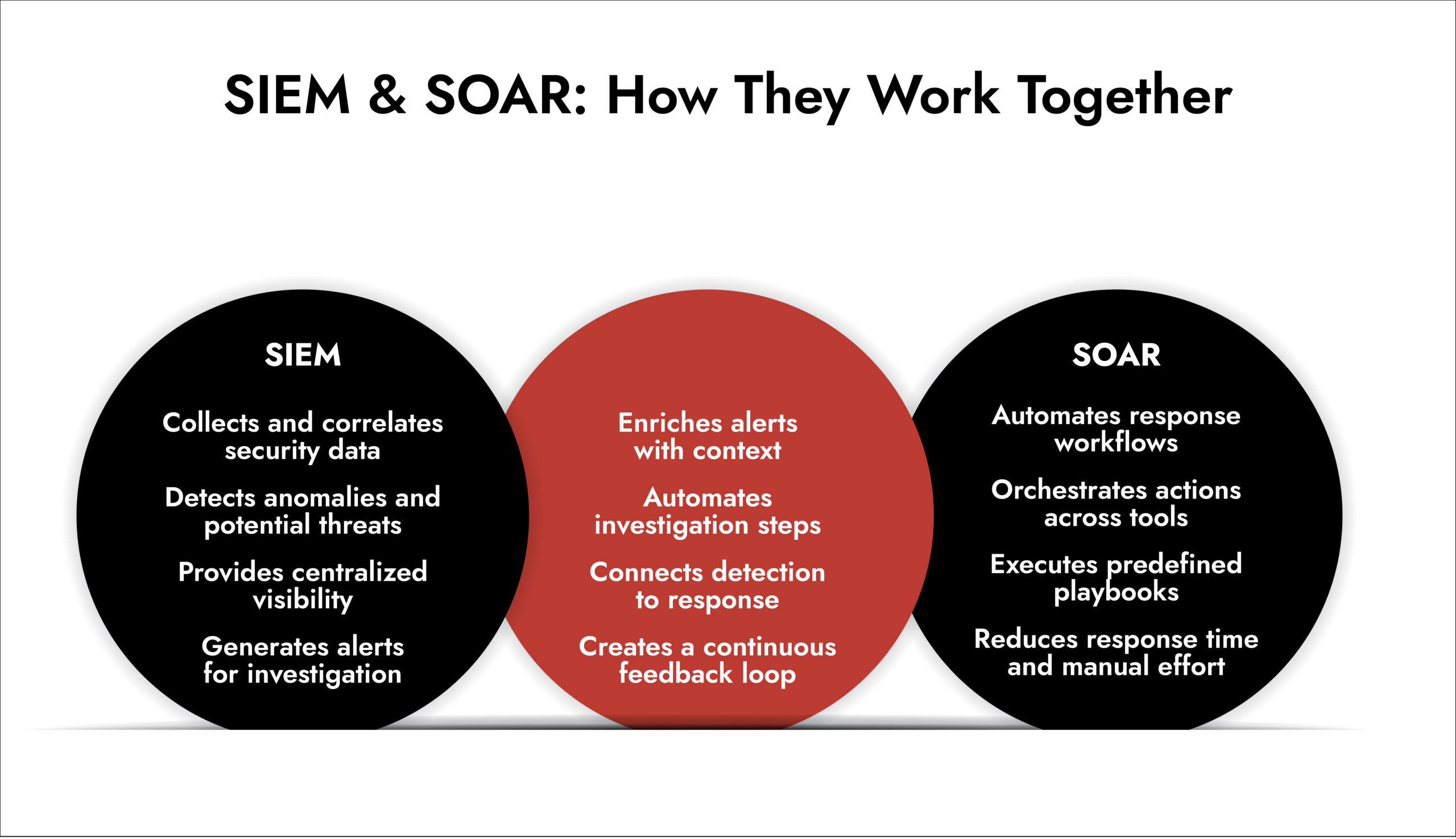
Practical Implementation: Sequencing and Strategy
Organizations approaching SIEM and SOAR implementation face real constraints: limited budget, stretched teams, competing priorities. The sequencing question matters operationally.
Start with SIEM when visibility gaps are the primary constraint. If you cannot answer basic questions about network activity, user behavior, or system state, SIEM solution establishes foundational visibility. Without detection capability, there is nothing to automate response for.
Move to SOAR when alert volume overwhelms response capacity. If analysts already have more alerts than they can investigate thoroughly, SOAR becomes the priority. Adding more detection without improving response capacity just increases the backlog.
Implement integrated platforms when building from scratch. Organizations without existing SIEM infrastructure might consider platforms combining both capabilities. Modern XDR and integrated security operations platforms merge detection and response into unified architectures.
Beyond initial deployment, maturity matters significantly. Basic SIEM implementation with out-of-box correlation rules provides limited value. Mature SIEM operations with tuned detection, custom correlation logic, and behavioral analytics deliver substantially more capability. Similarly, basic SOAR deployment with simple alert enrichment only scratches the surface. Mature SOAR operations with comprehensive playbooks and sophisticated orchestration transform security team effectiveness.
The benefits of SIEM and SOAR integration scale with implementation maturity, not just tool deployment.
Elevate Threat Detection and Response with NetWitness® SIEM
-Correlate data across users, logs, and network for unified visibility.
-Detect advanced threats with AI-driven analytics and behavioral insights.
-Accelerate investigations using automated enrichment and guided workflows.
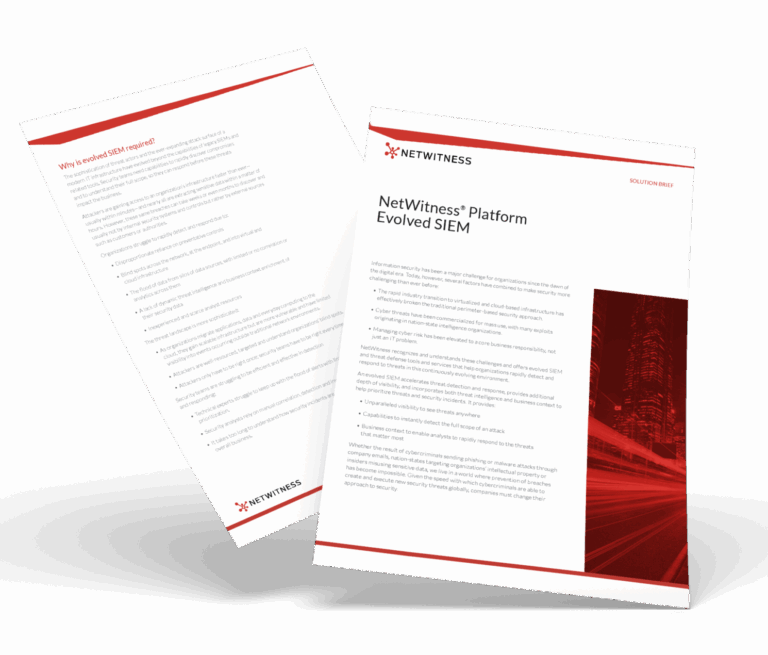
The Operational Reality Beyond the Technology
SIEM and SOAR tools do not solve security operations challenges alone. Detection logic requires continuous tuning based on false positive rates, missed detections, and evolving threats. Playbooks require ongoing development covering diverse incident types. Integration maintenance demands attention as security tools update regularly, changing APIs and data formats.
Organizational change management matters too. Shifting from manual investigation to automated playbook execution changes how analysts work. Successful SOAR adoption requires demonstrating that automation handles repetitive work so analysts can focus on complex problems requiring expertise.
The difference between SIEM and SOAR that matters most is not technical specification—it’s operational function within a broader security program. Both are necessary. Neither is sufficient alone. The real work lies in implementing them effectively and integrating them intelligently.
Conclusion
SIEM and SOAR aren’t standalone solutions—they’re complementary forces that close the gap between detection and response. SIEM gives teams deep visibility into activity across networks, endpoints, and users, uncovering early signs of compromise. SOAR builds on that intelligence, automating investigation steps and coordinating rapid, consistent responses across systems.
When integrated, they create a connected security ecosystem where every detection leads to action, and every action feeds intelligence back into detection. SIEM strengthens SOAR with richer data context; SOAR strengthens SIEM with feedback loops that refine detection accuracy. The result is a continuous cycle of visibility, automation, and improvement that keeps the SOC adaptive and resilient.
The takeaway is simple: SIEM helps you see what matters; SOAR ensures you act on it. Together, they elevate security operations from reactive alert management to proactive, intelligent defense—one where insight and action move in perfect sync.
Frequently Asked Questions
1. What is the difference between SIEM and SOAR?
SIEM aggregates and correlates security data to detect threats through pattern analysis and behavioral analytics. SOAR orchestrates security tools and automates investigation and response workflows. The architectural distinction: SIEM processes data to identify threats; SOAR processes threats to execute responses.
2. Can SIEM and SOAR work together?
Yes. SIEM detects threats and generates alerts that trigger SOAR playbooks. SOAR automatically investigates those alerts by querying multiple security tools, enriches them with context, executes response actions, and feeds investigation outcomes back to SIEM. This integration creates closed-loop security operations.
3. What are the benefits of integrating SIEM with SOAR?
Integration reduces mean time to response from hours to minutes through automated investigation. It ensures consistent, thorough investigation of every alert regardless of analyst availability. It mitigates alert fatigue by handling routine incidents automatically and escalating only complex threats.
4. Which tool should I implement first: SIEM or SOAR?
Implement SIEM first if visibility gaps are your primary constraint. Implement SOAR first if you have detection capability but cannot act on alerts effectively due to volume or resource constraints. Consider integrated platforms if building security operations from scratch.
5. What is an example use case of SIEM and SOAR integration?
SIEM detects anomalous authentication patterns suggesting credential compromise. This triggers a SOAR playbook that automatically queries threat intelligence for the source IP, checks the user’s recent activity, reviews endpoint logs for malware, assesses what resources the account accessed, disables the compromised account, forces password reset, and presents the analyst with a complete investigation—all in under a minute versus 30-60 minutes for manual execution.
Establish Incident Response consistency, speed, and scale with NetWitness® Orchestrator
